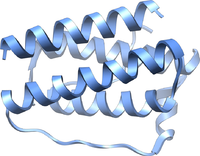
Photo from wikipedia
Senile osteoporosis is characterized by age-related bone loss and bone microarchitecture deterioration. However, little is known to date about the mechanism that maintains bone homeostasis during aging. In this study,… Click to show full abstract
Senile osteoporosis is characterized by age-related bone loss and bone microarchitecture deterioration. However, little is known to date about the mechanism that maintains bone homeostasis during aging. In this study, we identify adenosine monophosphate-activated protein kinase alpha 1 (AMPKα1) as a critical factor regulating the senescence and lineage commitment of mesenchymal stem cells (MSCs). A phospho-mutant mouse model shows that constitutive AMPKα1 activation prevents age-related bone loss and promoted MSC osteogenic commitment with increased bone-derived insulin-like growth factor 1 (IGF-1) secretion. Mechanistically, upregulation of IGF-1 signalling by AMPKα1 depends on cAMP-response element binding protein (CREB)-mediated transcriptional regulation. Furthermore, the essential role of the AMPKα1/IGF-1/CREB axis in promoting aged MSC osteogenic potential is confirmed using three-dimensional (3D) culture systems. Taken together, these results can provide mechanistic insight into the protective effect of AMPKα1 against skeletal aging by promoting bone-derived IGF-1 secretion.
Journal Title: Cell proliferation
Year Published: 2023
Link to full text (if available)
Share on Social Media: Sign Up to like & get
recommendations!